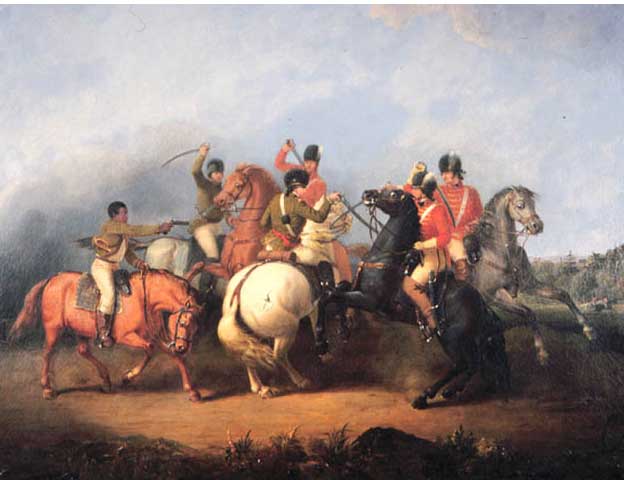Battle of Cowpens 1781

American General Morgan defeated a British force of regulars under the command of Colonel Tarleton. Morgan's troops enveloped the British in a classic military action that captured all of the British forces.
.
After Gates had been defeated at Camden, the Continental Congress authorized General Washington to appoint a new commander of the Southern armies. Washington selected General Greene, who had recently resigned as Quartermaster General. Greene headed south. Upon his arrival, Greene split his small army, sending General Morgan to western South Carolina to menace the British troops and attempt to threaten British Post #96.
British General Cornwalis responded by sending Colonel Tarleton, with about 1,000 soldiers, to Post #96. There, Tarleton received further orders from Cornwalis to seek out and destroy Morgan's forces. Morgan had 600 Continental soldiers and seasoned Virginia militia men, together with another 500 untrained militia men.
Morgan was surprised by the rapid arrival of Tarleton's men who rode rapidly to reach the location of Morgan and his men. Morgan decided to remain and fight Tarleton. Morgan placed his soldiers on a gentle, but commanding hill, deploying them in three lines. The most reliable soldiers among the Continental troops and Virginia militia were placed just forward of the crest. Below were two lines of militia, the furthest forward being the best sharpshooters. Morgan did not expect they would be able to stand against a line of British regulars, so he gave them explicit orders that they were to fire three rounds and then run to the place were the horses were being held. Morgan placed 130 mounted men in reserve under Colonel Washington.
Morgan's men were given a good night's sleep (as much as someone could sleep before a battle). Then he served them a hearty breakfast.
At 4:00 AM, January 17, 1781 Tarleton's forces broke camp. Morgan was duly notified. At 8:00 AM, Tarletons forces reached American lines. The first British scouts were cut down by American skirmishers. The main British force then attacked. It quickly crossed the difference between the lines. Morgan went up and down the line repeating the famous words: "Don't fire until you see the white of their eyes!" A fierce cry went out from the British forces: Morgan responded loudly, "They give us the British Hallo, boys. Give them the Indian Hallo, by God."
A wild cry went out from the Americans. The sharpshooters took aim and fired. They did their job, firing two or three times and running back to the second line. The British continued to advance and, as the second line began to fire, the British began to run up the hill with bayonets ready. The second line broke and withdrew and the British thought they had won the day.
British dragoons then tried to cut down the fleeing Americans. Just then, Washington's cavalry appeared and chased away the British cavalry. Morgan was awaiting the militia men where the horses were, and he managed to turn them back around toward the battle. Meanwhile, the final line of Continentals was holding off the British. The tactical situation forced them to retreat slightly. Tarleton thought the battle had been won, and he ordered a general charge. As they charged, Morgan ordered the retiring force of Continentals to turn and fire.
At the same time, the militia men were coming up on the left. Once the British were halted in their tracks, the Americans began charging with bayonets. Just then, the militia attacked from the left, and Washington's cavalry attacked from the right. The British lines totally collapsed and it was a total US victory.
It was the second victory in a short period for the Americans, coming soon after King's Mountain. This time, however, the Americans had faced and defeated regular British troops and not American Loyalists. The British had lost 910 men. 110 were killed and 800 were taken prisoner, along with all of their supplies. Comparatively, the Americans lost only 73 people, 12 were killed and 61 were wounded. It was clear the British Southern strategy was a failure.
 >
>